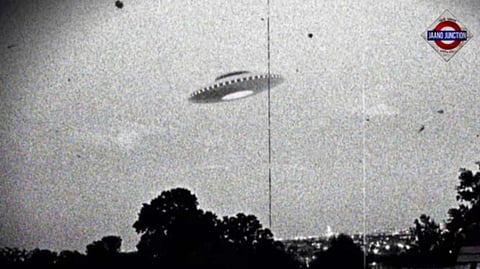

Every year, on July 2nd, the world comes together to celebrate World UFO Day. This day is dedicated to the acknowledgment and awareness of unidentified flying objects (UFOs) and the mysteries that surround them. Enthusiasts, researchers, and curious minds unite to discuss, analyze, and speculate about the phenomena that have captivated human imagination for decades.
The Origins/History of World UFO Day
World UFO Day was first celebrated in 2001, initiated by UFO researchers and enthusiasts who sought to bring greater awareness to the subject and encourage governments to declassify information related to UFO sightings. The choice of July 2nd commemorates the famous Roswell incident, which occurred in 1947 in New Mexico. This incident is one of the most well-known and controversial UFO events, involving the crash of an unidentified object and subsequent claims of a government cover-up.
The Roswell Incident and Its Impact
The Roswell incident began with reports of a mysterious object crashing on a ranch near Roswell. The initial military announcement described it as a "flying disc," but the story was quickly retracted, and the object was labeled as a weather balloon. This sudden change fueled conspiracy theories and speculation about a government cover-up. The incident remains a cornerstone of UFO discussions, embodying the tension between official narratives and public curiosity.
Significance/Importance of this day
Raising Awareness: It aims to educate the public about the historical and scientific aspects of UFO sightings, promoting a better understanding of what is often considered a fringe topic.
Encouraging Research: The day inspires amateur and professional researchers alike to delve into UFO phenomena, fostering scientific inquiry and skepticism.
Community Building: It provides a platform for enthusiasts and experiencers to share their stories and connect with like-minded individuals, creating a sense of community.
Promoting Openness: The day advocates for government transparency regarding UFO information, urging authorities to disclose data that may shed light on these unexplained occurrences.
UFO Phenomena: A Brief Overview
UFOs, defined as any aerial object that cannot be immediately identified, have been reported for centuries. Sightings range from lights in the sky to more detailed encounters involving structured craft. While many UFO sightings have been explained as natural or man-made phenomena, a small percentage remain unexplained, fueling speculation about their origins.
The study of UFOs, known as ufology, encompasses various disciplines, including astronomy, meteorology, and psychology. Ufologists analyze sighting reports, physical evidence, and witness testimonies to discern patterns and possible explanations.
Notable UFO Sightings
Beyond the Roswell incident, several notable UFO sightings have captured public imagination:
1. The Phoenix Lights (1997): Thousands of people in Arizona reported seeing a massive, V-shaped formation of lights moving silently across the sky.
2. The Rendlesham Forest Incident (1980): U.S. Air Force personnel stationed in the UK witnessed a series of unexplained lights and a craft in the woods near their base.
3. The Belgium Wave (1989-1990): A series of triangular UFO sightings were reported by hundreds of witnesses, including military personnel, in Belgium.
Events celebrated
Sky-Watching Gatherings: Enthusiasts gather in open spaces to watch the skies, hoping to spot unusual aerial phenomena. These events foster a sense of community and shared interest in the mysteries of the cosmos.
Lectures and Seminars: Experts in ufology, astronomy, and related fields give talks and presentations on recent findings, historical cases, and the science behind UFO sightings. These educational events help dispel myths and promote a more informed understanding of the subject.
Documentary Screenings: Films and documentaries about UFO sightings, alien encounters, and space exploration are screened to inform and entertain audiences. Notable films include "Close Encounters of the Third Kind," "The Phenomenon," and "Unacknowledged."
Discussion Panels: Forums and panels provide a platform for open dialogue between skeptics, believers, and researchers. These discussions help bridge the gap between different perspectives and encourage critical thinking.
Art and Culture Exhibits: Art installations, photography exhibits, and cultural displays explore the influence of UFOs and extraterrestrial themes on human creativity and imagination.
The Scientific Perspective
While popular culture often portrays UFOs with sensationalism, the scientific community approaches the subject with caution and rigor. Astronomers and physicists acknowledge that many UFO sightings can be attributed to natural phenomena, atmospheric conditions, or human-made objects such as satellites and aircraft. However, a small percentage of cases remain unexplained, prompting further investigation.
Organizations like the SETI Institute (Search for Extraterrestrial Intelligence) and various governmental agencies have dedicated resources to the search for extraterrestrial life and the study of unexplained aerial phenomena. The release of classified documents by governments, such as the U.S. Department of Defence declassified videos of UFO encounters, has added legitimacy to the ongoing scientific inquiry.
World UFO Day is celebrated in various ways around the globe. Enthusiasts may organize sky-watching events, host film screenings of classic UFO-related movies, and hold discussion panels featuring experts and witnesses. Social media platforms buzz with posts and conversations, allowing people to share their experiences and theories. As we look to the stars on this special day, we are reminded of the vastness of the universe and the possibility that we are not alone. Whether skeptics or believers, we all share a common curiosity about what lies beyond our world and what it means for our place in the cosmos.
